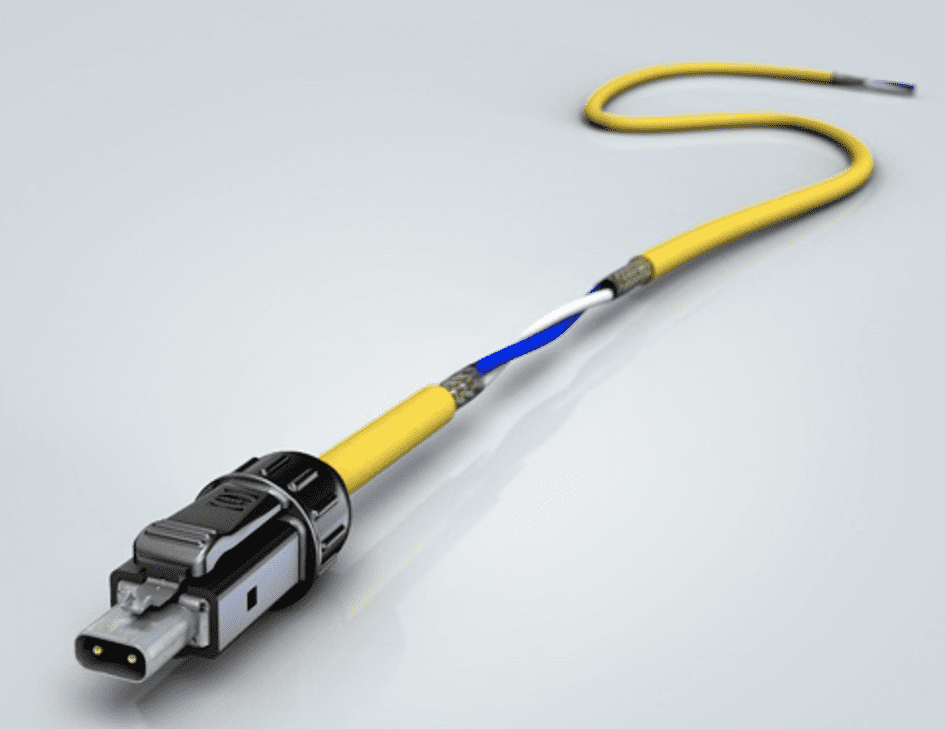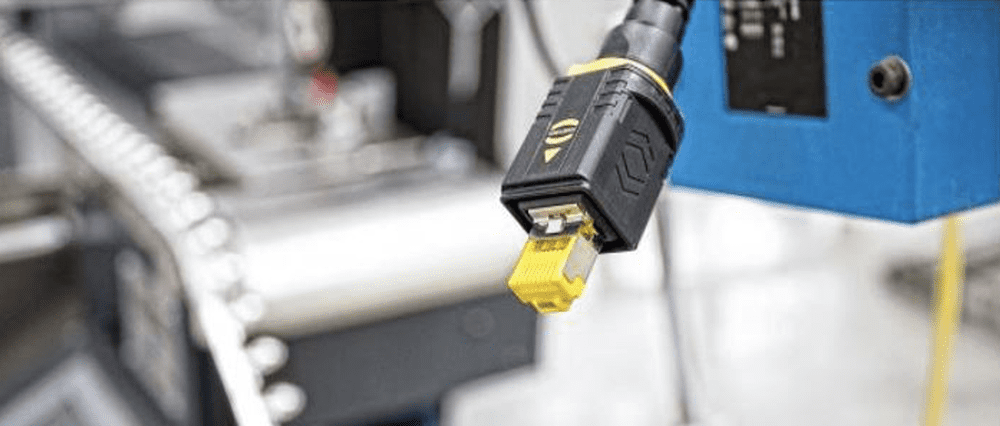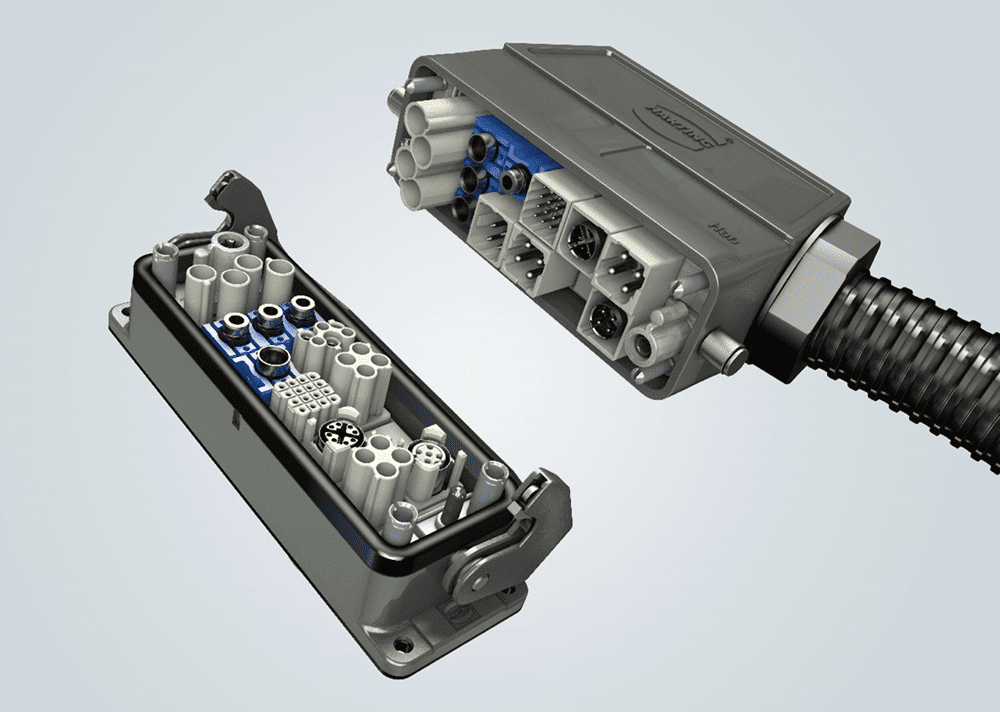Why Connectors are the Enabler of Industry 4.0
Industry 4.0. Industrial Internet of Things, IIoT, Smart Factory. These aren’t just buzzwords; they are generation-defining trends that are changing manufacturing.

Connectors play an important role in enabling the future of industrial automation. That raises the question: how can a single component play such a huge role in revolutionizing the entire manufacturing process? More than just a component in Industry 4.0, connectors are a fundamental building block to realizing its potential.
First, what exactly is Industry 4.0?
The term “Industry 4.0” is filled with promises: unparalleled operational efficiency, total production transparency, implementation of predictive maintenance models, and more. However, these promises are often presented as the result, without a concrete description of how to achieve it.
Industry 4.0 refers to specific technologies implanted into manufacturing processes. In 2016, the Institute of Electrical and Electronics Engineers (IEEE) defined four key themes for Industry 4.0:
- The ability of machines, devices, people, and sensors to communicate with one another.
- Information transparency. The ability for operators to access and utilize information gathered during all parts of the manufacturing process to identify places where efficiency could be improved.
- Technical assistance: The ability of technology to assist people in decision making or performing unsafe tasks.
- Decentralized decisions: The ability of cyber-physical systems to perform tasks autonomously and make decisions on their own.
Interconnection: Ethernet connectivity enables seamless communication from sensor to cloud
Industry 4.0 is for all devices, sensors, and machines, with a critical aspect being the communication between them. Machines have used data for decades; however, the data was locked away at the individual machine or device level. Data was not collected, collated, or used to make decisions. Industry 4.0 flips this practice on its proverbial head and allows all data to be used to build a complete picture of a system or machine.
Previously, data was important for “in the moment” functionality. Devices that use different data protocols, in a sense, didn’t speak the same language. Translating and collecting data was expensive, and storing it was even more of a challenge. Therefore, data existed in silos.
The cloud was a game-changer in enabling large amounts of data to be stored and processed without interfering with local servers and processes. The ability to keep data off-site in dedicated servers at an affordable price made it practical for companies to retain and use the data their machines were producing.
As a result, companies started to rethink their industrial networks. Old serial bus protocols began to decrease in popularity in favor of Ethernet, which is already widely used in cloud networks. The reason for this is that serial bus protocols would need to eventually be translated to Ethernet. Moreover, they are highly specialized and require years of experience and training to properly implement and support. Over the past years, Ethernet connectors have evolved from miniaturized versions of four- to eight-wire Ethernet connectors to single-pair Ethernet (SPE), which transmits Ethernet over two twisted wires, resulting in lower weight and copper costs. SPE is a financially viable option for every device on an industrial network.

T1 Industrial is the standard mating face for SPE and allows the transmission of Ethernet over two wires.
Smaller connectors enable information transparency without increasing device size
Devices are becoming smaller. This is true for cellphones and other consumer electronics, and for the human-machine interfaces (HMIs) people use when programming a robot on a machine. The components inside a device often limit how small the device can be. For example, 3.5 mm headphone jacks have been eliminated from many cellphones because, in addition to the rise in popularity of wireless earbuds, this connection point is a limiting factor in how slim the phone could be.
In Industry 4.0 networks, every device is expected to produce data, offer more functionality, and be connected to an operations center. This means the number of components is increasing on devices that are becoming smaller. Therefore, the components must become smaller. As a result, the demand for hybrid and smaller connectors has increased.
Ways that industrial connector manufacturers reduce connector size varies but can include removing latches for internal locking mechanisms or push tabs, reducing the overall profile of the connector, reducing the space needed between connection points, or combining functions like magnetics directly into the connector. All these design choices can enable device designers to do the seemingly impossible – reduce size while increasing functionality.

The PushPull connector uses an internal locking mechanism, which helps reduce the space required for a connector.
Technical assistance: Connectors enable cobots to work alongside humans
Collaborative robots, or cobots, were once the thing of science fiction. While that helpful at-home robotic butler is still some years out, workers in manufacturing plants may find themselves working alongside small cobots.
In the past, robots tended to be fixed in place. Hardwiring a robot instead of using a connector was suitable for some applications where the robot was intended to perform the same function repeatedly for the duration of its lifecycle. Now, cobots are designed with flexibility in mind, both in the tasks they perform and the location they inhabit on the production floor. Connectors let the robot be moved quickly and without reliance on skilled labor.
Decentralized decisions: Connectors make decentralized systems possible
Decentralized systems have become the preferred structure when designing a production floor. These systems contrast to older centralized systems where all machines and devices are connected to a single control panel and room. Decentralized systems are far more efficient by allowing decisions to occur at the site of the application (or the edge). By keeping controls near the application, parts of the system can function independently. This is extremely important when flexibility is needed.
Changing a centralized system is time-consuming and expensive because all connections and cables must be pulled and rerouted to a new location. Likewise, changing a centralized system often requires troubleshooting to ensure that new processes don’t interfere with older ones. Decentralized systems operate independently of each other, so changes can be made easily and without endangering the rest of the system.
In a decentralized system, hardwiring is not a viable option. On modern production floors changing a layout or even switching out parts of a machine is a common practice. Connectors prevent expensive downtime by making these adjustments easy and fast for workers to accomplish without specialized tooling. The most efficient connectors are modular connectors that allow multiple connection points to be combined into one housing. The next level of connector modularity allows the customization of the module itself, ensuring all space is used as efficiently as possible.

The Han-Modular Domino is the next level of modularity. Users can customize modules with the specific interconnects needed for an application.
Connectivity is a critical area of Industry 4.0 and connectors are no longer optional when designing machines, devices, or sensors used in modern manufacturing equipment. Well-designed connectors that offer space-savings and modularity help manufacturers realize the promises of Industry 4.0 while using reliable, time-tested technology.
By Nazario Biala, Industry Segment Manager, Automation, and Daniel Wood, Industry Segment Manager, Machinery, at HARTING
Visit HARTING to learn more about interconnect solutions for automation.
Like this article? Check out our other Ethernet and Industry 4.0 articles, our Industrial Market Page, and our 2023 and 2022 Article Archives.
Subscribe to our weekly e-newsletters, follow us on LinkedIn, Twitter, and Facebook, and check out our eBook archives for more applicable, expert-informed connectivity content.





